Ireland’s ‘Norman’ castles
Published in Features, Issue 3 (May/June 2019), Volume 27What did the ‘Normans’ ever do for us? We can debate the pluses and minuses, but one thing that’s hard to ignore, even today, is our landscape dotted with their castles.
By Linzi Simpson and Seán Duffy
For many people, the imprint on Ireland of the people often called the Anglo-Normans can be summed up in a single word—castles. By the early modern period Ireland’s was the most castellated landscape in Europe, the great majority having been built by descendants of those individuals who began to conquer it and to colonise it in 1169.
Of course, this does not mean that the Irish knew nothing of fortification before then: whatever else they may have been, Dún Aonghasa, Dunseverick, the Grianán of Aileach, Rathgall in Wicklow, Staigue Fort in Kerry and countless more like them were fortifications—indeed, fortresses. The Irish had even begun experimenting with castles themselves in the decades leading up to the invasion. In 1124, when the king of Connacht, Tairdelbach Ó Conchobair, was making a bid for the high-kingship, he began building three separate castles (and more were to follow) which were of such new appearance that the writers of the Irish annals coined new terms—caisteóil, caislén, caistél—by which to describe them. Later, the man who invited the Anglo-Normans into Ireland, Diarmait Mac Murchada of Leinster, would himself build a caisteóil or tech cloiche (‘stone house’) at Ferns. We have no idea what ‘castles’ like these looked like, but their construction tells us that those who sought and won power in twelfth-century Ireland realised the advantages—and increasingly, perhaps, the necessity—of fortifications in order to hold on to that power.
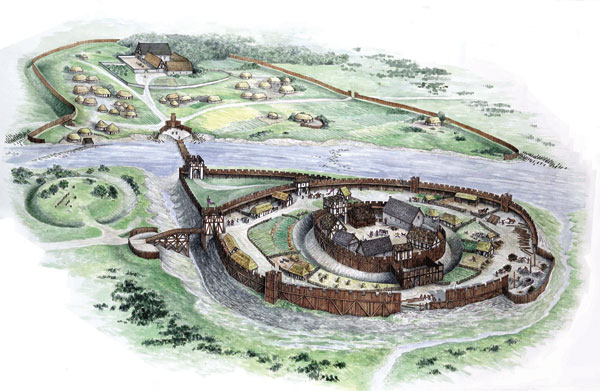
Above: Artist’s impression of the motte and bailey structure originally built by Hugh de Lacy at Trim, Co. Meath. (Uto Hogerzeil)
The first castle men
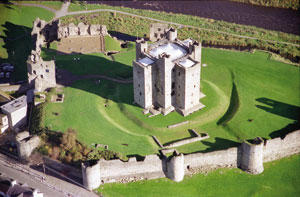
Above: Almost immediately de Lacy began to build what would become the most imposing Anglo-Norman stone castle ever constructed in Ireland, a stout curtain wall and a moat filled with water from the Boyne encircling a magnificent donjon or keep. The present structure was completed after his death in 1186. (OPW)
This was especially true of the Anglo-Normans who began to arrive on the island in the late 1160s, having been promised lands there by Mac Murchada in return for military service to him. The early leaders—the likes of Robert fitz Stephen and Maurice fitz Gerald—were the sons and grandsons of men ultimately of Norman extraction who, after 1066, spearheaded the attempt of England’s new Norman kings to conquer South Wales from its native rulers. There they built castles for the king and acted as his constables in them, and in time would carve out lordships of their own, which were administered from and defended by their own castles. They were castle men and, when they sought greener pastures in Ireland in the 1160s, what followed was inevitably conquest by castle.
As had been the case in England and Wales, the great majority of the early castles were mottes, large flat-topped mounds on top of which a wooden tower was erected. Many mottes still survive in Ireland today—perhaps as many as 400, although it can sometimes be hard to tell a badly degraded motte from some other kind of natural or man-made feature. Needless to say, none of the original wooden towers have survived the ravages of time, but we can get a sense of how impressive mottes were in their prime from a place like Clough Castle, Co. Down, where a later medieval stone tower still adorns the top of the mound. Many, if not all, mottes had a bailey attached to them, an external courtyard defended by a ditch and palisade, where outbuildings and workshops were no doubt situated and livestock housed. Approximately 160 can be identified in the field, though their outline can be hard to determine with the naked eye.
Another type of earthwork, the ringwork castle, also had its part to play. This type of fortification, which is very difficult to identify in the field, was almost the reverse of a motte, comprising circular or subcircular enclosures defined by large enclosing banks and ditches. While approximately 135 potential examples have been identified in the National Monuments Database, they require significantly more detailed study, mainly because of their similarity to other monuments such as ringforts. The identification of this type of castle as an Anglo-Norman monument really requires archaeological excavation.
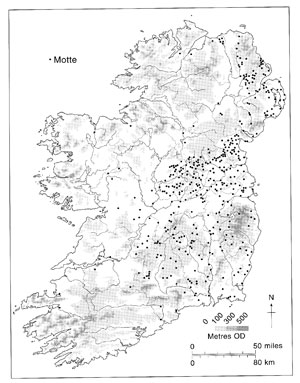
Above: This distribution map of mottes (after Glasscock [1975]) gives a fair sense of the pattern of Anglo-Norman conquest.
We must not, however, think of mottes as isolated outposts like the proverbial US cavalry fort in a John Ford movie about the American frontier. The majority were seigneurial caputs, the residences and administrative centres—and in some cases chartered boroughs—of the lordly and knightly class established in Ireland after 1169 by successive kings of England and their tenants-in-chief. The crown’s tenants-in-chief were men like Richard de Clare (Strongbow), who was granted all of Leinster apart from the existing towns and their hinterland, or Hugh de Lacy, who was granted the vast lordship of Meath, stretching from the Shannon to the Irish Sea. Both men turned parchment grants into permanent colonies by carving up their lordships among lesser barons and knights who had taken the gamble of following them to Ireland, and it was typically the lordships of these lesser men that had a motte and bailey at their core.
Builders in stone
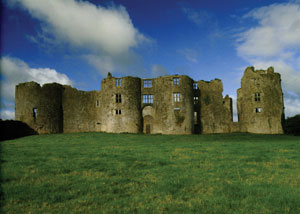
Above: The Crown also invested in magnificent castles at strategic locations as the conquest proceeded, such as this thirteenth-century structure at Roscommon.
There is another reason why we cannot chart the early course of Anglo-Norman settlement in Ireland by simply plotting the location of mottes. This is because, contrary to what is sometimes believed, it is not the case that all early castles were of earth and timber and that stone and mortar castles came later. Some stone castles are quite early indeed. There was, of course, no better way of announcing to the world that you were here to stay than to embark on the lengthy and expensive construction of a stone castle. The ink was barely dry on the charter granting Meath to Hugh de Lacy when he began building at Trim what would become the most imposing Anglo-Norman stone castle ever constructed in Ireland, a stout curtain wall and a moat filled with water from the Boyne encircling a magnificent donjon or keep. Not long afterwards John de Courcy built a very different residence—much less complex in terms of architectural design, albeit massive—to secure the coastline at Carrickfergus, and Theobald Walter (ancestor of the Butlers) built at Nenagh an equally distinctive great round tower as part of his lordly residence.
These men were among the greatest aristocrats in the new colony, but lesser men, too, built in stone from an early date—think of the early Geraldine castles at Shanid and Croom, Co. Limerick, the residences of the Talbots at Malahide or the Tyrrells at Castleknock. The Crown also invested in magnificent castles in towns that tended to stay in royal hands (e.g. Dublin, Limerick, Dungarvan, Roscrea) and at strategic locations as the conquest proceeded (e.g. Athlone, Clonmacnoise, Rindoon and, later in the thirteenth century, Roscommon).
The thirteenth-century building boom
The great castles of Anglo-Norman Ireland are largely thirteenth-century in date. One thinks of the castles built in Leinster by Strongbow’s successors, the Marshals, including Ferns, Carlow, Kilkenny, Dunamase and Lea, or Dundrum, Co. Down, which de Courcy began before his untimely demise at the hands of the de Lacys, who, besides Trim, probably also began Carlingford Castle on the southern shore of Carlingford Lough and Greencastle guarding its northern shore. It was their allies, the de Verdons, who erected a magnificent fortress north of Dundalk at Castleroche. And as the de Burgh family rose in prominence in Connacht throughout the century, they reinforced their dominance with castles at Athenry, Co. Galway, Ballintober, Co. Roscommon, Ballymote, Co. Sligo, and—after they acquired the earldom of Ulster—the other Greencastle, overlooking Lough Foyle in Donegal.
From crash to recovery
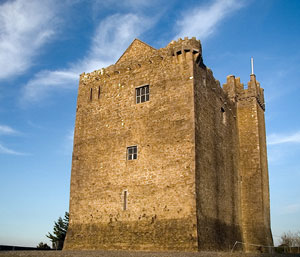
Above: Not all tower-houses were ‘Norman’. This one, Redwood Castle, Co. Tipperary, was the site of a law school maintained by the Mac Aodhagáin clan, who were hereditary brehons.
While the clichéd image of Ireland in the fourteenth century may be exaggerated—that of an English colony in decline, beset by natural disasters such as the Great European Famine and the Black Death and by an Irish resurgence triggered by the Bruce Invasion—the general pattern was one of economic and political decline. And since the building and maintenance of castles depends on a time of plenty, it was only when conditions improved that castle construction resumed. When it did, the preference was for buildings which, though commonly thought of as ‘Norman castles’, are in fact tower-houses, the earliest of which date from at least 200 years (and some up to 400 years) after the initial invasion, many not even built by descendants of the invaders but by Gaelic lords. Typically, these are a square tower with a vaulted ground floor and perhaps three upper floors, having one main room in each. The principal room was often on the first floor, having a good chamber above and lesser rooms in the attics. Many had an attached compound called a ‘bawn’ (from Irish badhún, ‘cattle enclosure’).
Tower-houses were not the castles of the great. Their main builders were the gentry class, the comfortably off rural clergy and, in towns like Galway and Kilkenny, the richer merchants. In addition, as Gaelic lords—whose ancestors had been at the receiving end of the aggression and acquisitiveness of the original invaders back in the twelfth century—recovered land and lordship in the late Middle Ages and married into the gentry families descended from those invaders, they were not slow to keep up with the Joneses (or rather with the Burkes and Barrys, Condons, Costellos and Cusacks, Plunketts, Powers and Prendergasts, Taaffes, Talbots, Tuites and Tyrrells) and build their own tower-houses.
Linzi Simpson is a consultant in archaeology and built heritage; Seán Duffy lectures in medieval history in Trinity College Dublin.
FURTHER READING
T. McNeill, Castles in Ireland: feudal power in a Gaelic world (London, 1997).
D. Sweetman, The medieval castles of Ireland (Cork, 1999).
















